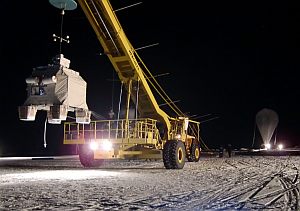For the exploration of the stratosphere, scientists are using giant balloons that transport heavy payloads of more than 500 kg to altitudes above 30 km. At the low air pressure prevailing up there, these balloons have a diameter of about 90 m. By the KIT balloon experiment, the complete diurnal variation of the chemistry in the arctic polar vortex at temperatures near -90°C has now been measured for the first time.
On January 24, 2010, 1:46 hrs, the scientific payload of 750 kg coordinated by the Institute of Meteorology and Climate Research (IMK) of Karlsruhe Institute of Technology (KIT) started for a flight of 13 hours to the center of the polar vortex with a temperature of nearly -90°C. The balloon was launched by the Swedish Space Corporation from the ESRANGE Space Center near Kiruna and reached a height of about 34 km. Never before has a balloon of this size been launched in the North polar winter at such low temperatures. The helium-filled balloon reached a volume of 400,000 m3 at the highest point, which corresponds to a sphere of about 90 m in diameter.
“During the start the temperature on the ground was -29°C only,” explains the scientific project leader Hermann Oelhaf from the KIT Institute of Meteorology and Climate Research. “While the experiment ascended through the cold lower stratosphere, the gas temperature in the balloon even dropped to -101°C. We therefore had to carefully control the ascend speed by opening a valve and by releasing ballast in order to prevent the balloon shell from cracking which would happen at temperatures of about -105°C.”
The scientific payload of the balloon gondola consisted of three instruments for the remote sounding of the chemical composition inside the polar vortex: MIPAS-B, TELIS, and DOAS. MIPAS-B is the balloon version of the MIPAS infrared spectrometer developed by KIT-IMK that is also flying aboard the European satellite ENVISAT. TELIS is a microwave spectrometer operated jointly by the German Aerospace Center (DLR) in Oberpfaffenhofen and the Dutch space organization SRON. The DOAS instrument is run by the Institute for Environmental Physics, University of Heidelberg, and operates in the ultraviolet and visible spectral ranges. The combination of these three instruments on one single balloon is unique worldwide. It allows to measure precise height profiles of more than 30 trace gases in the stratosphere during both day and night.
The main objectives of the IMK balloon mission were the observation of day/night variations of chlorine- and bromine-containing compounds responsible for the decomposition of the ozone layer and the validation of atmosphere measurements from space (in particular with instruments on the ENVISAT satellite and the international space station ISS). The balloon flight was co-financed by the German Space Agency DLR.
The balloon flight also was coordinated with the international RECONCILE measurement campaign that is currently being carried out at Kiruna and in which KIT is involved as well. Within this campaign, the airplane version of MIPAS is used on the Russian high-altitude research aircraft Geophysica.
The data obtained from these campaigns are needed for the in-depth scientific understanding of stratosphere chemistry leading to ozone loss in the polar vortex and for studying climate-chemistry interactions. Based on the findings obtained, the researchers will be able to improve numerical models for the simulation of atmospheric processes and to more reliably forecast climate in the medium and long term.
In close partnership with society, KIT develops solutions for urgent challenges – from climate change, energy transition and sustainable use of natural resources to artificial intelligence, sovereignty and an aging population. As The University in the Helmholtz Association, KIT unites scientific excellence from insight to application-driven research under one roof – and is thus in a unique position to drive this transformation. As a University of Excellence, KIT offers its more than 10,000 employees and 22,800 students outstanding opportunities to shape a sustainable and resilient future. KIT – Science for Impact.

